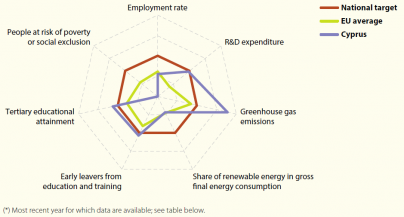Archive:Europe 2020 indicators - Cyprus
- Data from December 2014. Most recent data: Further Eurostat information, Main tables.
This article is part of a set of statistical articles based on the Eurostat publication Smarter, greener, more inclusive? - Indicators to support the Europe 2020 strategy. It provides recent statistics on the Europe 2020 strategy of the European Union (EU), focusing on the situation in Cyprus.

Source: Eurostat, see dedicated web section: Europe 2020 indicators
Explanations on this radar chart are available here.
Main statistical findings

Source: Eurostat, see dedicated web section: Europe 2020 indicators
In 2013, Cyprus continued to exceed its national target on tertiary educational attainment, despite a fall of two percentage points compared with the year before. By 2012 the country had also recorded a reduction in GHG emissions three times larger than the one envisaged in its Europe 2020 commitment. Cyprus also met its target on early leavers from education and training in 2013 and came close to its target on R & D expenditure. Despite the twofold increase in the share of renewable energy over the period 2006 to 2012, Cyprus remained at some distance from its national target. Developments in social inclusion and employment have been much less favourable. The number of people at risk of poverty or social exclusion has increased substantially since 2008, and in 2013 Cyprus showed the largest gap towards its national target across the EU. Similarly, employment rates have dropped since the onset of the crisis in 2008, placing Cyprus well below its national target.
Data sources and availability
More information about the origin of the data and the calculation of indicators can be obtained via the Europe 2020 indicators dedicated website.
Under 'Tables', click on the icons next to the indicators:
- 'Explanatory texts (metadata)' for a detailed overview of the collection and compilation methods;
- 'Information on the leaf' for data availability per country.
A more general overview of quality procedures can be found in Implementation of standard reference-metadata for indicators - the ESMS Indicator Profile (ESMS-IP) (PDF file).
Context
Europe 2020 is the EU’s growth and jobs strategy for the current decade, striving to pave the way to a smart, sustainable and inclusive future. The strategy envisages measures to overcome the economic crisis and move beyond it by addressing the structural weaknesses in the European economic model. The final objective is to deliver high levels of employment, productivity and social cohesion in the Member States, while reducing the impact on the natural environment.
See also
Further Eurostat information
Publications
- Smarter, greener, more inclusive - indicators to support the Europe 2020 strategy (online publication, also downloadable as PDF file)
Main tables
Dedicated section
Methodology / Metadata
- Towards robust quality management for European Statistics - Communication from the Commission COM(2011) 211 final
Other information
- Regulation 223/2009 of 11 March 2009 on European statistics